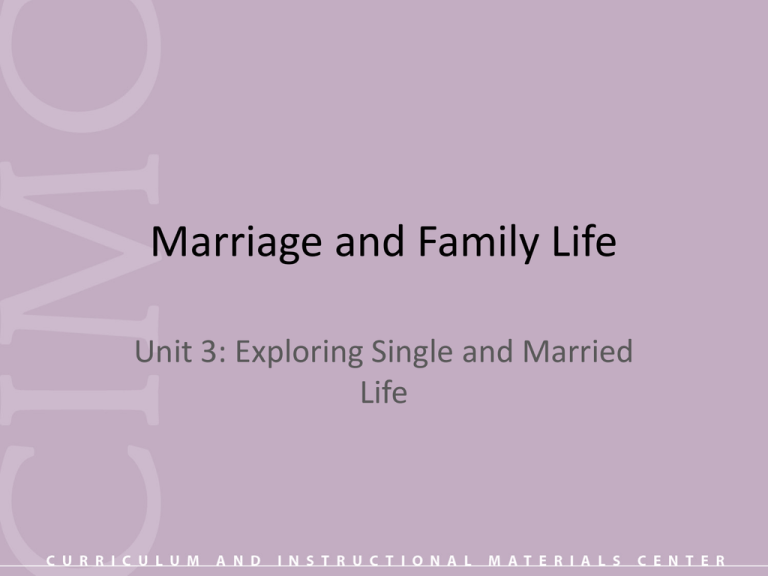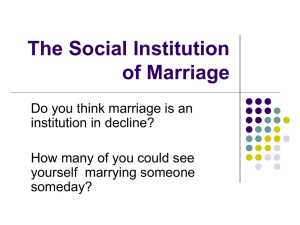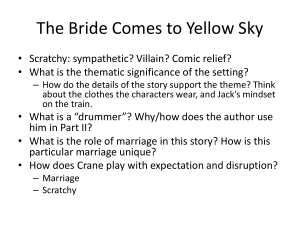
Marriage and Family Life
Unit 3: Exploring Single and Married
Life
Objective 1: Profile single and married
lifestyles.
Single lifestyle
• More time for self and for personal interests
• Greater privacy
• Greater independence
• Focus on career and other personal goals
• Sustained by a strong network of friends
• Responsibilities borne by the individual
Objective 1: Profile single and married
lifestyles.
Married lifestyle
• Shared experiences of daily life
• Lifelong companionship
• Greater financial security (from pooled resources)
• Shared commitment to one relationship
• Shared responsibilities
• Greater emotional security
• Focus on common goals
Objective 2: Identify factors that
influence lifestyles.
• Where you want to live
• Type of work you enjoy
• Type of personal and
family life you want
• Importance of money
and career
• Pace of living
• Leisure activities you
enjoy
• Attitude toward
marriage or single life
• Circumstances
• Beliefs and values
• Family and friends
• Career goals
• Finances and other
resources
Objective 3: Identify factors that
influence the decision to remain
single.
•
•
•
•
•
•
Importance of independence and “freedom”
Fear of failure
Commitment to education and/or career
No interest in marriage and/or parenting
Lack of a compatible partner
Desire to delay marriage
Objective 3: Identify factors that
influence the decision to remain
single.
•
•
•
•
Desire to remain financially independent
Need to care for a sick or elderly relative
Ability to care for yourself
Financial stability
Objective 4: Select options for single
living.
•
•
•
•
•
Living alone
Becoming or remaining a single parent
Living with a partner
Living with a roommate
Living with family members
Objective 5: Identify implications of
living with another person.
• Fewer legal property rights for either person in the
relationship
• Custody issues may arise when children are involved
• Combines aspects of single and married living
without traditional husband and wife roles
• Legally single, but emotionally committed to a
partner
• Reduces living expenses for each person
Objective 5: Identify implications of
living with another person.
• May allow a person to get to know another person
better
• May allow either or both persons to avoid personal
commitments
• Potential for parental/community disapproval
• May be fewer legal issues if the relationship ends
• Not eligible for most of the legal benefits of marriage
Objective 6: Identify factors that
influence the decision to marry.
•
•
•
•
•
•
•
Age
Feelings about commitment
Compatibility
Desire to parent or current pregnancy
Financial security/economic support
Independence from family
Desire for intimacy
Objective 6: Identify factors that
influence the decision to marry.
•
•
•
•
•
•
Loneliness
Marriage laws
Mature love
Parental approval
Proximity
Social pressure/expectation
Objective 7: Develop a personal and
family life goal plan.
Objective 8: Explore personal attitudes
about single and married lifestyles.
Objective 9: Distinguish between love
and infatuation.
Love
• Takes more time to establish. Love reflects growth in a
relationship
• Combines strong personal attachment and attraction
• Is a give-and-take relationship.
• Involves sharing and trusting
• Accepts the other person (including faults)
• Requires mutual respect
• Shows concern for what is best for the other person.
Objective 9: Distinguish between love
and infatuation.
Infatuation
• Has a strong physical element
• May not be rational.
• Involves a strong but often temporary
attraction
• Overlooks undesirable traits.
• Seldom lasts long
• Is usually one-sided
Objective 10: Distinguish between the
stages of a romantic relationship.
Dating
• Allows people to spend time as a couple and to
develop their friendship
• Provides an opportunity to learn more about
yourself.
• Helps you use and improve various skills.
• Acts as an opportunity to learn more about other
people in a variety of settings.
• Activities revolve around the interests of you and
your date.
Objective 10: Distinguish between the
stages of a romantic relationship.
Engagement
• Is the last stage of dating and signifies the start of
a couple’s plans for marriage
• Serves as a formal announcement to friends and
family
• Acts as a testing period and time to discuss
important issues not already discussed
• Allows time to plan the wedding and obtain a
marriage license
Objective 10: Distinguish between the
stages of a romantic relationship.
Wedding
• Marks the beginning of a life together
• Announces the marriage to the public
• Legally binds the couple during a civil or
ceremonial service
• The honeymoon provides time for the newly
married couple to adjust to each other and to
share some intimate time together
Objective 11: Identify the adjustments
that marriage requires.
•
•
•
•
•
•
Making decisions together
Managing your finances together
Making decisions about careers
Learning to communicate effectively
Finding areas of common interest
Deciding on roles
Objective 11: Identify the adjustments
that marriage requires.
• Finding a place to live
• Handling the habits, routines, and schedules
of daily living
• Handling changes in social activities and
relationships
• Nurturing relationships with in-laws
• Managing day-to-day conflicts
Objective 12: Rank factors of personal
importance for a successful marriage.
Objective 13: Identify the scope of
marriage laws.
• All marriages require the mutual consent of
both partners
• Neither person can be married to someone
else
• Both people must be mentally competent
• Marriage is a legal contract that has to be
legally dissolved
• Many states require blood tests before
marriage
Objective 13: Identify the scope of
marriage laws.
• All states have a minimum age requirement
• A marriage license is required, except in the
case of common law marriage
• A licensed official must perform the marriage
ceremony
• Most states will not allow marriages of people
related by blood
• Many states have laws prohibiting marriages
between two people of the same sex
Objective 14: . Profile marriage laws
and wedding customs.








